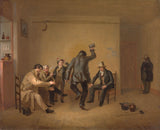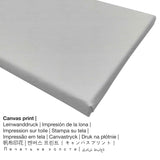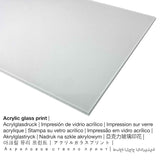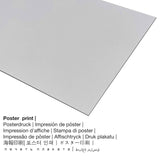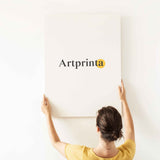William Sidney Mount, 1835 - Ihe ngosi Bar-room - mbipụta nka mara mma
Ụtụ gụnyere. Mbupu gbakọrọ na ndenye ọpụpụ.
Product nkọwa
a 19th narị afọ piece of art "Bar-room Scene" was made by the master William Sidney Mount in 1835. The 180 year old painting measures the size 57,4 × 69,7 cm (22 5/8 × 27 7/16 in). Mmanụ na kwaaji was used by the North American painter as the medium of the artpiece. The original artwork's inscription is: "signed, lower left: "W. S. Mount/1835"". It is in the the collection of Ụlọ ọrụ Art Chicago. Nke a masterpiece, nke dị na ngalaba ọha is being supplied with courtesy of Art Institute Chicago. : Ihe nchịkọta William Owen Goodman na Erna Sawyer Goodman. Ndozi n'ime odida obodo format ma nwee oke onyonyo nke 1.2: 1, nke pụtara na ogologo bụ 20% ogologo karịa obosara.
Họrọ nhọrọ ihe onwunwe
Maka mbipụta nka ọ bụla dị mma anyị na-enye ihe dị iche iche & nha dị iche iche. Ị nwere ike ịhọrọ nha na ihe kachasị amasị gị n'ime nhọrọ ndị a:
- Kwaaji: The canvas print, which should not be mistaken with an artwork painted on a canvas, is a digital replica applied on a cotton canvas material. Besides, canvas print creates a cosy, enjoyable impression. Hanging a canvas print: The advantage of canvas prints is that they are relatively low in weight, which implies that it is quite simple to hang up your Canvas print without any wall-mounts. Canvas prints are suitable for any kind of wall.
- Mbipụta akwụkwọ mmado (ihe kwaaji): The poster is a UV printed canvas with a fine structure on the surface. Please note, that depending on the size of the poster we add a white margin of something between 2-6cm around the print in order to facilitate the framing with your custom frame.
- Mbipụta enyo acrylic: The print on acrylic glass, which is sometimes denoted as a plexiglass print, will change the original work of art into home décor and is a viable alternative option to canvas or aluminium dibond prints. The work of art will be custom-made with the help of state-of-the-art UV printing machines. It creates intense, deep color tones. The great advantage of an acrylic glass art print is that sharp contrasts as well as image details will be more visible with the help of the delicate gradation.
- Mbipụta nke aluminom: An Aluminium Dibond print is a material with an impressive depth effect - for a modern impression and a non-reflective surface. A direct Aluminium Dibond Print is your excellent start to the sophisticated world of fine art reproductions produced with aluminum. The direct print on Aluminum Dibond is one of the most popular entry-level products and is an extremely stylish way to display art reproductions, as it puts 100% of the viewer’s attention on the whole artwork.
Important legal note: We try whatever we can to depict the art products as accurate as it is possible and to display them visually on the various product detail pages. Please bear in mind that the colors of the print materials and the print result can vary marginally from the presentation on the monitor. Depending on the screen settings and the quality of the surface, colors can unfortunately not be printed one hundret percent realistically. Because our art reproductions are processed and printed by hand, there might as well be slight variations in the motif's size and exact position.
Nkọwa ngwaahịa
| Nkewa edemede: | nka nka |
| Usoro mmeputakwa: | mmeputakwa n'ụdị dijitalụ |
| Production usoro: | Mbipụta UV ozugbo (mbipụta dijitalụ) |
| Nlụpụta: | emere na Germany |
| Stockdị ngwaahịa: | a na-achọ |
| A na-atụ aro iji ngwaahịa eme ihe: | ihe ndozi mgbidi, mgbidi gallery |
| Ndozi onyonyo a: | usoro odida obodo |
| Oke akụkụ onyonyo: | 1.2: 1 - ogologo: obosara |
| Nsonaazụ: | ogologo bụ 20% ogologo karịa obosara |
| Ihe mmeputakwa dị: | ígwè obibi akwụkwọ (aluminium dibond), ebipụta canvas, mbipụta enyo acrylic (nwere ezigbo mkpuchi iko), mbipụta akwụkwọ mmado (akwụkwọ kwaaji) |
| Mbipụta kanvas (akwa akwa na etiti ihe ndọtị) dị iche iche: | 60x50cm - 24x20", 120x100cm - 47x39", 180x150cm - 71x59" |
| Mbipụta iko acrylic (nwere ezigbo mkpuchi iko) nhọrọ nha: | 60x50cm - 24x20", 120x100cm - 47x39" |
| Mpempe akwụkwọ mmado (akwụkwọ kwaaji) nha dị iche iche: | 60x50cm - 24x20", 120x100cm - 47x39" |
| Mbipụta nke aluminom: | 60x50cm - 24x20", 120x100cm - 47x39" |
| ụba: | adịghị |
Nkọwa ahaziri nke ihe osise
| Aha nke ihe nka: | "Bar-room Scene" |
| Nhazi: | sere |
| Otu izugbe: | nkà nke oge a |
| Time: | 19th narị afọ |
| Emepụtara na: | 1835 |
| Afọ nka: | karịa afọ 180 |
| Ọkara nke ihe osise izizi: | mmanụ na kwaaji |
| Akụkụ nke ihe osise izizi: | 57,4 × 69,7 cm (22 5/8 × 27 7/16 na) |
| Akanyere (ọrụ nka): | signed, lower left: "W. S. Mount/1835" |
| Egosiputara na: | Ụlọ ọrụ Art Chicago |
| Ebe ebe ngosi nka: | Chicago, Illinois, Njikota Obodo Amerika |
| website: | www.artic.edu |
| Ụdị ikike nka: | ngalaba ọha |
| Site n'aka: | Ụlọ ọrụ Art Chicago |
| Ebe kredit nke ọrụ nka: | Ihe nchịkọta William Owen Goodman na Erna Sawyer Goodman |
Banyere omenka
| Aha onye nka: | William Sidney Mount |
| Aha nka ndị ọzọ: | William Sidney Mount, mount william sydney, Mount William S., Mount, Mount William Sidney, william s. mount |
| okike onye nka: | nwoke |
| Nationality: | American |
| Ọrụ: | onye na-ese ihe |
| Obodo onye nka: | United States |
| nhazi ọkwa: | omenkà nke oge a |
| Afọ ọnwụ: | 61 afọ |
| Afọ ọmụmụ: | 1807 |
| Amụrụ na (ebe): | Setauket, Suffolk County, New York steeti, Njikota Obodo Amerika |
| Afọ nwụrụ: | 1868 |
| Ebe ọnwụ: | Setauket, Suffolk County, New York steeti, Njikota Obodo Amerika |
© Nwebiisinka - ikike ọgụgụ isi nke, www.artprinta.com (Artprinta)
Nkọwa ihe osise izizi sitere na ụlọ ngosi nka (© Nwebiisinka - nke Art Institute Chicago - Ụlọ ọrụ Art Chicago)
William Sidney Mount specialized in scenes of everyday life, known as genre paintings. He was one of the earliest American artists to do so, and his compositions, including Bar-room Scene, were rich in narrative and humor and engaged with the complex cultural, political, and racial circumstances that defined antebellum society. Here Mount portrayed a boisterous group of patrons in a country tavern. The seated men encourage the drunken dance of the central figure, whose tattered clothes and inebriated state suggest a less fortunate position. Standing in the back corner is an African American figure, who, as a free black man in 1830s New York, was able to frequent the public tavern, but, as Mount makes clear visually, did not participate fully or equally in this community.

